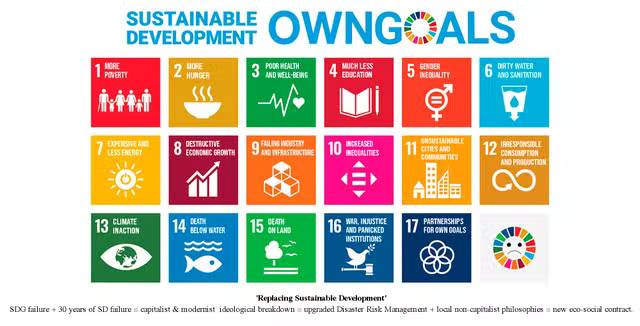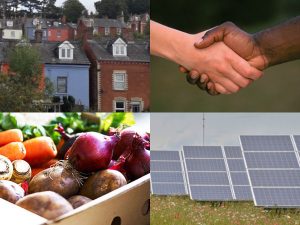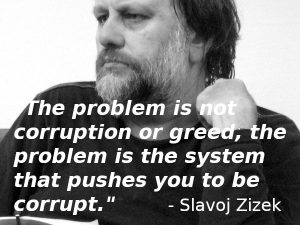I always assumed that the Millennium Development Goals, and since 2016, the Sustainable Development Goals were unequivocally good things. The United Nations, caring for all people, sets targets for the improvement of the human lot in various specific ways: reducing poverty and hunger, improving access to clean water, electricity, education, and such like. Until recently I didn’t realise that these goals, and the way they are implemented, are based on some very questionable ideas.
Let’s take ‘Sustainable Development’. This ideology was widely adopted in the late 90s as a compromise between the need for most countries to grow to catch up with the West, and the realisation that resources are finite and that the greenhouse effect was a threat. Of course, the rich countries, who pull all the strings in the UN, had already developed unsustainably, and would continue to develop without UN support, so however ‘sustainability’ was supposed to restrict development didn’t apply to them. Meanwhile ‘less developed’ countries were paid to develop, essentially more slowly, and to fall further behind in the economic race.
Beneath that is the notion of development itself, which goes back some decades further. Development is the public name for what rich countries ‘do’ to poor countries. It entails lending them hard currency, guiding them to spend the money in the ‘right’ way – much of which involves buying rich countries’ technology, shaping their economies towards exporting raw materials, ensuring they don’t slide too far to the left, and of course increasing the standard of living, or at least GDP. This is a cynical take, of course, but scholars more learned than I have called it neo-colonialism. And when development projects fail to generate local wealth, which is often, the end result is much the same as colonisalism.
At LowImpact we imagine development in a very different way – not poor countries becoming more like rich ones – but all communities becoming more self reliant in their environments, happier yet coordinated in order to be able to tackle global issues. As David Fleming, in Lean Logic, explains:
large-scale problems do not require large-scale solutions; they require small-scale solutions within this kind of large-scale framework
We imagine technology increasing the resilience and autonomy of communities and people, rather than plugging everyone into a single global technology-control grid with many points of technical and political failure. Instead of those proprietary technologies competing in the marketplace to maximise profit, we think that technology serves us much better when done in the spirit of open source collaboration.
All this development discourse is premised on a cultural expectation of economic growth and ‘progress’. People and politicians alike have come to depend, psychologically and structurally, on civilisation expanding and improving forever. This is evident in narratives around economic growth (including ‘green growth’) – the subject of SDG no. 8 – which appears oblivious to the finite nature of energy, rare earth metals, productive land etc, and deaf and blind to the need for rich countries to scale back consumption by an order of magnitude. The SDGs instead assume that we can all get richer if we just manage resources more carefully and fairly. This is a myth.
The slowing of ‘progress’ is becoming more and more apparent economically and politically. A UN report last month included this:
Humanity’s broken risk perception is reversing global progress
The same report, going into more detail, blamed economic growth which is, awkwardly, as we mentioned, SDG number 8.
A new paper by Prof. Jem Bendell proposes that the whole SDG framework should be ditched for all these reasons. Development, in the context of progress, is accelerating our civilisation towards its physical limits in ways that almost appear calculated to cause maximum damage and suffering. This week Bendell showed up at a conference of the United Nations Office for Disaster Risk Reduction (UNDRR) with a public letter signed by 100 academics stating that the Sustainable Development framework should be replaced with Disaster Risk Reduction, because the future will be more about disasters than about development.
The letter highlighted a particular approach to disaster preparedness, which is gaining strength, called locally-led adaptation, which is an attempt to make sure the recipients of ‘development’ are also the main beneficiaries.
As I said, the SDGs don’t have much bearing on developed countries, but the rise in disasters, especially wildfires and floods, is noticeable, so more emphasis on preparedness seems like a good thing. The whole development agenda has a very mixed track record and we agree that ‘Sustainable Development’ is sounding more and more like an oxymoron.












3 Comments
A very interesting concept which to my mind is closer to the truth than many would care to get, especially those from the so called “First World”.
Sadly as mentioned in here and also as proved dramatically over the last few months (in more ways than one) there is a need, a very large need, to ensure that whilst trade must be considered a good thing the majority of countries must, to protect themselves from many different ‘disasters’ (both man and Nature made) that could and are affecting many different countries from the smallest to the largest and that, to put it simply, must be that each country MUST, WITHIN IT’S OWN MEANS become self sufficent to a certain degree. That must of course must include every form of growth and manufacturing that exists in the world today. Which includes both the means and abilities to feed the country and manufacture the means to carry out those activities – e.g. It’s all very well to have enough land to grow food in excess of requirement however this falls down dramatically if we neither have the ability to grow/rise the necessary foodstuff or the equipment to do so – if you need tractors to carry out that harvesting but the only place within range that produces those tractors is in a foreign land who could so easily stop exporting those tractors to you – Blackmailing basically!
I’d be very interested to find out peoples views on that sort of activity – does the country continue to rely (Fingers crossed) on this foreign land to produce your tractors and the nessesary fuel required to run them . . . . . or “do you bite the bullet” and use a different form of transport etc. that you have a lot of even if your people have to relearn the use of that equipment, like using horses?
Mike – yes, I think the principle of subsidiarity is important. Some things, like keeping a few chickens, growing some veg, planting a fruit tree etc. are appropriate at the household scale. Others are more suited to the community scale – for example it would make more sense to have a blacksmith’s forge, pottery kiln, natural soaps production or bread ovens operating for the whole community, rather than trying to establish them in each household. Then maybe there could be companies producing natural paints or soft furnishings, say, for the county, and then each country could manufacture laptops and cellphones, rather than relying on one country to supply the entire world, and requiring them to be transported around the globe. It’s not impossible, either, for the co-operative sector to produce phones and laptops, rather than having to give our money to extractive, global corps (see https://www.lowimpact.org/posts/co-operative-smartphones-are-coming-nithin-coca-interviews-the-chair-of-kdim-co-op); or for those electrical goods to be repaired in communities – https://www.lowimpact.org/posts/restart-parties-prolong-the-life-of-your-electrical-goods-and-pick-up-some-useful-skills-in-the-process. Kevin Carson would go further, and say that 3D printing now means that many more things can be produced in communities now than before the existence of this tech. The mining of some minerals will be concentrated in one or a few countries, because that’s what we’ve inherited – but that doesn’t have to be the case with manufacturing or food production. Local is best for several reasons, but local could cover different areas depending on the product.
I think this argument is sound. If there is one thing that has been found to be true, is that no two villages, or towns, or cities, or states, or countries are entirely alike. They all have different needs and nuances of needs and it can be folly to attempt to treat them all the same – to implement development the same in all of the countries. It is even more laughable to attempt to tackle problems the same way globally.
A view that has gained traction with us as we work in communities is that solutions have to be customised at hyperlocal (village) level at best, or at local (subnational) level at least to cumulatively find that we are solving the world’s problems. Unfortunately, the global goals still use some pretty dated metrics for development – GDP being the worst of them, in my view, but also (somewhat controversially) education levels, which presume that education happens in schools because transition from primary to secondary to tertiary schools is high. In my country high school students have been found to have challenges reading simple words or doing addition.
These global goals mean different things in different communities, who have entirely different priorities. We need to shift the power of development from international donors and large NGOs, from National governments even to village leaders, community-based organisations and local government representatives. It means that we need to empower community stakeholders to make more decisions, have more say in the design of the projects that impact them, and have the resources they need to manage them.